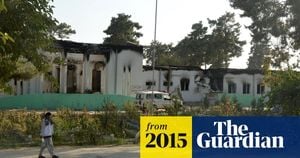A magnitude 4.9 earthquake struck Northern Morocco late on Monday night, sending tremors felt across parts of Southern Spain and even reaching southern Portugal. The quake, which occurred at approximately 23:48 local time (22:48 GMT) on February 10, 2024, had its epicenter near Ksar el-Kébir, about 80 kilometers south of Tangier. According to reports from the Instituto Geográfico Nacional (IGN), the earthquake registered at a depth of 34 kilometers, placing it within the seismically active region known as Tanger-Tétouan-Al Hoceima.
The tremors were reported to be perceptible across various municipalities in Spain's Andalusian region. Cities including Sevilla, Huelva, and Cádiz reported experiencing the seismic activity, with the Emergency services confirming they received numerous calls throughout the night. Locals expressed concerns over the tremors they felt, especially considering the memory of catastrophic quakes in the past.
"The activity was felt with intensity II and III across multiple municipalities," stated the IGN. Key areas impacted included Alcalá de Guadaíra, Guillena, and the capital city of Sevilla, along with other localities like Estepona, Fuengirola, and the province of Cádiz, such as Algeciras and San Roque.
Local sources have reported no fatalities or significant damages related to the quake as of now. According to the news agency MAP, "Local sources reported there were no fatalities," which is reassuring after the devastation caused by previous earthquakes. Similar reports came from the surrounding Moroccan towns, where tremors were also felt, especially in larger cities like Rabat and Fez.
The region surrounding Ksar el-Kébir is known for its seismic activity, influenced by the interaction between the Eurasian and African tectonic plates. The frequency of earthquakes here means the local population has some preparedness for such events, but the concern remains high following the catastrophic earthquake of September 8, 2023. That quake, which registered at 6.8 on the Richter scale, left nearly 3,000 people dead and over 5,000 injured, resulting in large-scale destruction of homes and infrastructure.
While many smaller earthquakes occur without incident, the recent activity emphasizes the need for continuous monitoring and preparation for larger quakes. Residents expressed relief at the absence of serious consequences from the 4.9 shaker, yet the experience served as another reminder of the seismic threats pervasive throughout the region.
To date, authorities have not issued significant alerts or actions following this quake, anticipating no immediate threats. Nevertheless, preparedness for the unexpected remains critically important. Municipalities are encouraged to maintain emergency protocols and keep residents informed about safety measures.
This earthquake demonstrates once again the vulnerabilities faced by regions along tectonic borders. Seismic experts and local officials urge communities to remain vigilant, as the natural occurrences are often unpredictable. The experience shared by many during the February earthquake is indicative of the risk and readiness residents must continue to cultivate.
Interestingly, the Moroccan government and scientific establishments have initiated programs to boost public awareness about earthquake preparedness. Local workshops aim to educate citizens about emergency responses should future tremors strike. The importance of this initiative cannot be overstated, especially considering the turbulence experienced just months prior.
Seismic waves crossed international borders during this recent tremor, connecting communities through shared experiences of fear and reaction. Local residents across the southern Iberian Peninsula discussed the event, highlighting the unique geological and social interplay incurred by such natural disasters.
This earthquake reminds the area of its active geological nature; the residents ended their night filled with anxious anticipation and tentative discussions about what such occurrences entail for their lives and homes.
Authorities will continue to analyze data and update the public as they receive more details. Monitoring stations across Morocco and Spain will keep watch to evaluate the potential for aftershocks or similar seismic activity. Understanding patterns and statistics can help frame future responses, ensuring the safety of communities affected by such inevitable geological events.
Though this latest tremor may not have caused physical damage, it undoubtedly shook the foundations of emotional resilience among the communities familiar with living on the edge of seismic unpredictability. The whispers of tremors serve as reminders of the rock-solid reality these regions must navigate daily.
For now, the tranquility seems to have resumed its hold across the communities between Morocco and Southern Spain. But as always, residents and authorities alike remain attentive, prepared for whatever may come next from the earth beneath.



